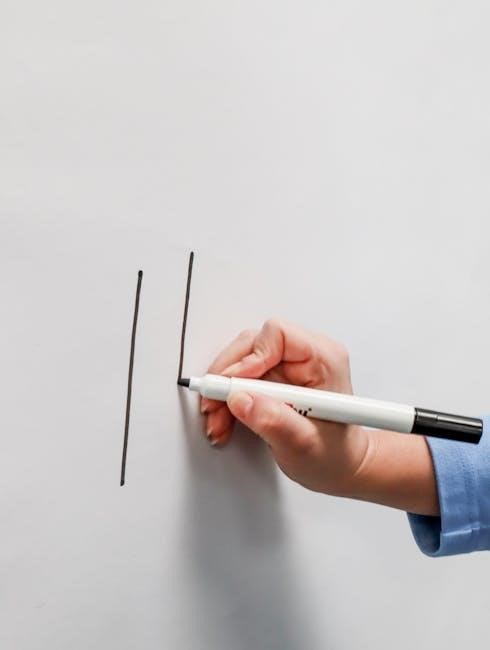The M1 Garand Instruction Manual provides comprehensive guidance on operation‚ maintenance‚ and safety for users. It ensures safe handling and optimal performance of the historic rifle.
1.1 Overview of the M1 Garand Rifle
The M1 Garand is a gas-operated‚ semi-automatic rifle that was the first of its kind adopted by the U.S. military‚ designed by John C. Garand. It is chambered for the .30-06 Springfield cartridge and features an en-bloc clip-fed system‚ holding eight rounds. Known for its reliability and firepower‚ the M1 Garand became iconic during World War II and the Korean War. Its operation involves a piston-driven mechanism that cycles the action‚ ejecting spent cartridges and chambering new rounds. The rifle’s design emphasizes durability and ease of use‚ making it a favorite among soldiers and collectors alike. This manual provides detailed guidance for its operation and maintenance.
1.2 Importance of the Instruction Manual
The M1 Garand Instruction Manual is essential for safe and effective use of the rifle. It provides detailed guidance on operation‚ maintenance‚ and troubleshooting‚ ensuring users understand the firearm’s mechanisms and proper handling procedures; The manual is crucial for both novice and experienced shooters‚ offering clear instructions to prevent accidents and maintain the rifle’s performance. It covers critical aspects such as loading‚ unloading‚ and emergency procedures‚ as well as cleaning and lubrication. By following the manual‚ users can ensure the rifle functions reliably and safely‚ preserving its historical significance and operational integrity for future generations. It is a vital resource for all M1 Garand enthusiasts.
1.3 Historical Context of the M1 Garand
The M1 Garand‚ designed by John C. Garand‚ was the first gas-operated‚ semi-automatic rifle adopted by the U.S. military‚ replacing the bolt-action M1903 Springfield in 1936. It played a pivotal role in World War II and the Korean War‚ becoming iconic for its reliability and firepower. Over 5 million units were produced‚ with its .30-06 cartridge and en-bloc clip system setting a new standard for military firearms. The M1 Garand’s historical significance lies in its revolutionary design‚ which influenced modern rifle development. Its durability and effectiveness earned it the nickname “the greatest battle implement ever devised‚” leaving a lasting legacy in firearms history.

Understanding the M1 Garand Rifle Components
Understanding the M1 Garand’s components is essential for effective operation. Key parts include the receiver‚ bolt‚ operating rod‚ and stock‚ each serving specific roles in its gas-operated‚ semi-automatic function.
2.1 Key Parts of the M1 Garand
The M1 Garand rifle features distinct components designed for its gas-operated‚ semi-automatic function. The receiver acts as the core housing the action‚ while the bolt cycles to chamber and eject rounds. The operating rod connects to the gas system‚ enabling automatic operation. The stock provides stability and control‚ and the rear sight allows for precise aiming. The trigger mechanism initiates firing‚ and the en-bloc clip holds eight .30-06 Springfield cartridges. These parts work harmoniously to ensure reliable performance‚ making the M1 Garand a legendary firearm in military and civilian use.
2.2 Functionality of Each Component
The M1 Garand’s components work together to enable its semi-automatic operation. The receiver houses the bolt and operating rod‚ which cycle to chamber rounds. The bolt locks and unlocks the action‚ while the operating rod transfers gas pressure to cycle the rifle. The stock supports the shooter‚ and the rear sight adjusts for elevation. The trigger mechanism initiates firing‚ and the en-bloc clip feeds eight rounds into the chamber. Each part is essential for reliable performance‚ ensuring the rifle functions smoothly and accurately‚ making it a durable and effective firearm for both military and civilian use.
2.3 Diagrams and Visual Guides
The M1 Garand instruction manual includes detailed diagrams and visual guides to help users understand and maintain the rifle. These illustrations provide a clear view of the rifle’s components‚ such as the bolt‚ operating rod‚ and en-bloc clip system. Step-by-step disassembly and assembly diagrams are included‚ along with exploded views of key parts. Visual guides also depict the proper handling techniques‚ loading procedures‚ and safety checks. These diagrams are essential for both novice and experienced users‚ ensuring accurate maintenance and operation. They complement the written instructions‚ making complex procedures easier to follow and understand.

Safety Guidelines and Precautions
Always handle the M1 Garand with care‚ ensuring the muzzle points in a safe direction. Store unloaded and use only the correct caliber ammunition to prevent accidents.
3.1 General Safety Rules
Always treat the M1 Garand as if it were loaded and keep the muzzle pointed in a safe direction. Ensure the rifle is unloaded before handling or storing it. Use only the correct caliber ammunition specified in the manual to avoid damage or accidents. Keep fingers away from the trigger until ready to fire‚ and maintain control of the rifle at all times. Wear eye and hearing protection during use. Never modify the rifle without professional guidance‚ and regularly inspect for wear or damage. Follow all local laws and regulations when handling firearms.
3.2 Proper Handling and Storage
Always handle the M1 Garand with care‚ ensuring it is unloaded before storage or transport. Use a sling or rifle case to protect the firearm during movement. Store the rifle in a cool‚ dry place‚ away from children and unauthorized individuals. Keep the rifle in a gun safe or secure case when not in use. Regularly inspect the rifle for wear or damage before and after storage. Avoid exposing the firearm to extreme temperatures or moisture‚ as this can affect its performance and longevity. Follow local laws and regulations for firearm storage to ensure compliance and safety.
3.3 Emergency Procedures
In case of a malfunction‚ immediately point the muzzle in a safe direction. For a jam‚ pull the operating rod handle fully rearward to eject any chambered round. If the rifle fails to fire‚ ensure the safety is off and the magazine is loaded correctly. If a round is stuck‚ carefully remove it using a cleaning rod or seek professional assistance. Never force a jammed round‚ as this can cause damage. Always wear eye protection during any clearing procedure. Keep bystanders away and follow proper safety protocols to prevent accidents. Regular practice of these steps ensures quick and safe resolution of emergencies.

Operating the M1 Garand Rifle
Operating the M1 Garand involves loading the en-bloc clip‚ chambering a round‚ and firing. Engage the safety catch when not firing. Always aim carefully and squeeze the trigger smoothly. After firing‚ unload by removing the clip and ejecting any remaining cartridge. Follow safety protocols to prevent accidents;
4.1 Loading the Rifle
Loading the M1 Garand involves inserting an 8-round en-bloc clip into the magazine. Ensure the rifle is on safe and the muzzle is pointed in a safe direction. Open the bolt by pulling the operating rod handle rearward‚ then insert the clip into the receiver until it clicks securely. Release the operating rod to chamber the first round. The clip will eject automatically when empty. Always verify the chamber is loaded or unloaded by visually inspecting it. Keep your finger off the trigger during loading and unloading to prevent accidental discharge. Follow proper safety protocols at all times;
4.2 Unloading the Rifle
To unload the M1 Garand‚ ensure the muzzle is pointed in a safe direction and the safety is engaged. Pull the operating rod handle fully rearward to eject the en-bloc clip. If the chamber is loaded‚ a round will be ejected. Visually inspect the chamber to confirm it is empty. Always keep your finger off the trigger during unloading to prevent accidental discharge. Store the rifle unloaded when not in use‚ following proper safety protocols. Regularly practice unloading to ensure proficiency and safety. This procedure ensures the rifle is secure and ready for storage or maintenance.
4.3 Firing the Rifle
Before firing‚ ensure the rifle is properly loaded and the safety is disengaged. Aim carefully‚ keeping the muzzle pointed in a safe direction. Squeeze the trigger smoothly to avoid jerking the rifle. The M1 Garand fires in a controlled‚ semi-automatic manner‚ ejecting the en-bloc clip automatically when empty. After firing‚ always engage the safety and visually inspect the area to ensure no one is in the line of fire. Keep the muzzle downrange until the immediate area is confirmed clear. Proper firing techniques ensure accuracy and safety‚ making the M1 Garand a reliable choice for target shooting or historical reenactments.

Maintenance and Cleaning
Regular maintenance ensures the M1 Garand functions reliably. Clean the barrel‚ bolt‚ and operating rod thoroughly after use. Lubricate moving parts as specified to prevent wear.
5.1 Cleaning the Rifle
Cleaning the M1 Garand is essential for maintaining its performance and longevity. Start by ensuring the rifle is unloaded. Use a cleaning rod and brush to remove residue from the barrel. Apply a mild solvent‚ let it sit briefly‚ then scrub thoroughly. Wipe down the bolt‚ operating rod‚ and receiver with a soft cloth. Pay special attention to the chamber and magazine area. Use a dry patch to remove excess solvent and residue. Avoid harsh chemicals or abrasive materials that could damage the finish. Regular cleaning ensures smooth operation and prevents corrosion. Always follow the manual’s specific cleaning procedures.
5.2 Lubrication Points
Proper lubrication is critical for the M1 Garand’s smooth operation. Apply a lightweight oil or grease to key components such as the operating rod‚ bolt‚ and receiver rails. The trigger mechanism and magazine well should also be lightly lubricated. Use a clean‚ lint-free cloth to wipe off excess oil‚ ensuring no residue accumulates. Avoid over-lubrication‚ as it can attract dust and debris. Regular lubrication prevents corrosion and ensures reliable cycling of the action. Refer to the manual for specific lubrication points and recommended products. Proper lubrication maintains the rifle’s functionality and longevity‚ ensuring it performs optimally in various conditions.
5.3 Inspection and Repair
Regular inspection of the M1 Garand is essential for maintaining its reliability and performance. Begin by examining the barrel for wear‚ erosion‚ or fouling. Check the operating rod and bolt for signs of excessive wear or damage. Inspect the stock for cracks or dents and ensure all screws and bolts are tightly secured. Look for corrosion on metal surfaces and clean or apply rust inhibitors as needed. Lubricate moving parts and ensure the trigger mechanism functions smoothly. For repairs‚ refer to the manual for guidance on replacing worn or damaged components. Regular inspection helps prevent malfunctions and ensures the rifle remains in optimal condition.

Troubleshooting Common Issues
Identify jams‚ malfunctions‚ or stoppages by checking the chamber and magazine. Perform immediate action: pull the operating rod rearward‚ release‚ and aim; Ensure safe direction and clear obstructions to prevent damage.
6.1 Identifying Malfunctions
Identifying malfunctions with the M1 Garand involves checking for common issues like jams‚ misfeeds‚ or failure to eject. Start by ensuring the rifle is pointed in a safe direction. Perform immediate action by pulling the operating rod handle rearward and releasing it. Check the chamber for obstructions and inspect the magazine for proper alignment. If issues persist‚ examine the ammunition for damage or incorrect caliber. Additionally‚ inspect the gas system for blockages and ensure all components are clean and functioning properly. Refer to the manual for detailed diagnostic steps and solutions to address specific problems effectively.
6.2 Clearing Jams and Stoppages
Clearing jams and stoppages in the M1 Garand requires careful‚ methodical steps. First‚ ensure the muzzle is pointed in a safe direction. Perform immediate action by pulling the operating rod handle fully rearward with the palm up‚ then releasing it to reset the mechanism. If the issue persists‚ remove the en-bloc clip and inspect the chamber for obstructions. Use a cleaning rod or pencil to clear any blockages. If a round is stuck‚ carefully extract it manually. Always ensure the rifle is unloaded before attempting detailed troubleshooting; Refer to the manual for specific techniques to resolve jams effectively and safely.
6.3 Resolving Common Problems
Common issues with the M1 Garand‚ such as feed failures or ejecting problems‚ can often be resolved by ensuring proper lubrication and inspecting for worn or damaged parts. Check the operating rod and bolt for alignment and cleanliness. If rounds fail to chamber correctly‚ verify the en-bloc clip is fully seated. For persistent jamming‚ disassemble the rifle and clean the barrel and chamber thoroughly. Inspect the gas cylinder for blockages and ensure all components are tightly secured. Regular maintenance and inspection can prevent many issues. Always refer to the manual for detailed troubleshooting steps to restore functionality effectively.

Accessories and Modifications
Explore recommended accessories like scopes‚ slings‚ and bayonets to enhance functionality. Modifications such as aftermarket parts and custom stocks can personalize the M1 Garand for specific needs.
7.1 Recommended Accessories
To enhance the functionality and user experience of the M1 Garand‚ several accessories are highly recommended. A telescopic sight or scope mount can improve accuracy for long-range shooting. Slings are practical for carrying the rifle comfortably over long distances. Bayonets‚ both original and replica‚ add versatility for close-quarters situations. Magazine pouches and en-bloc clips ensure quick reloading. Additionally‚ a high-quality cleaning kit is essential for maintaining the rifle’s performance and longevity. These accessories not only enhance the rifle’s utility but also preserve its historical integrity for collectors and enthusiasts.
7.2 Installing Aftermarket Parts
Installing aftermarket parts on the M1 Garand requires careful consideration to ensure compatibility and authenticity. Begin by selecting parts specifically designed for the M1 Garand to maintain its historical integrity. Always follow proper installation techniques‚ such as using the correct tools and adhering to torque specifications. Some owners opt for modern scopes or ergonomic stocks‚ while others choose historical reproductions. Professional installation is recommended to avoid damaging the rifle or compromising its performance. Properly installed aftermarket parts can enhance functionality without sacrificing the rifle’s original charm. Ensure all modifications align with safety guidelines and respect the firearm’s legacy.
7.3 Customization Options
The M1 Garand offers various customization options to enhance its functionality and aesthetic appeal. Owners can replace the stock with alternatives such as walnut‚ fiberglass‚ or synthetic materials for improved durability or a modern look. Scopes and mounts can be installed for better accuracy‚ while trigger upgrades provide a smoother pull. Engraving or refinishing the rifle allows for personalization‚ preserving its historical charm. Additionally‚ aftermarket components like enhanced sights or rail systems can be added for tactical use. These modifications can enhance the rifle’s performance without compromising its legacy‚ making it a versatile choice for both collectors and shooters.

Historical Use and Significance
The M1 Garand‚ developed by John Garand‚ was the first gas-operated‚ semi-automatic rifle adopted by the U.S. military‚ revolutionizing firearm design and military tactics during WWII and Korea.
8.1 Development and Adoption
The M1 Garand‚ designed by John C. Garand‚ was developed at Springfield Armory to replace the bolt-action M1903 Springfield. Approved in 1935‚ it became the U.S. military’s first gas-operated‚ semi-automatic service rifle‚ chambered for the .30-06 cartridge. Its innovative en-bloc clip system allowed eight-round reloads‚ enhancing battlefield efficiency. Adoption marked a significant shift from manual to automatic operation‚ modernizing infantry capabilities. This rifle’s development set a new standard for reliability and firepower‚ paving the way for future firearm designs.
8.2 Military Service History
The M1 Garand served as the primary U.S. military rifle from World War II through the Korean War and into the early Vietnam War. Its reliability‚ accuracy‚ and semi-automatic capability made it a groundbreaking weapon for infantry. Introduced in 1936‚ it saw extensive combat in WWII‚ where its eight-round en-bloc clips provided a significant advantage over bolt-action rifles. The Garand remained in service until replaced by the M14 in the late 1950s. Its legacy endures as a symbol of American military innovation‚ with many still used ceremonially by honor guards and drill teams today.
8.3 Legacy and Impact
The M1 Garand left an indelible mark on firearms history‚ revolutionizing military and civilian rifle design. As the first standard-issue semi-automatic rifle‚ it influenced the development of modern firearms like the M14 and M16. Its reliability and effectiveness in WWII and Korea solidified its reputation as a legendary weapon. Today‚ the Garand remains a cherished collector’s item and a symbol of American ingenuity. Its design principles continue to inspire gunmakers‚ while its historical significance ensures its place in military and cultural heritage. The Garand’s legacy extends beyond combat‚ shaping shooting sports and civilian ownership of semi-automatic rifles.

Collector’s Guide to the M1 Garand
The M1 Garand is a highly sought-after collector’s item due to its historical significance‚ innovative design‚ and role in WWII and Korean War. Its enduring popularity stems from its reliability‚ craftsmanship‚ and the legacy of John C. Garand. Collectors value its rarity‚ condition‚ and historical provenance‚ making it a prized addition to any firearms collection.
9.1 Identifying Authentic Models
Identifying authentic M1 Garand models requires attention to detail‚ as reproductions and modified rifles can be misleading. Look for the manufacturer’s markings‚ such as “Springfield Armory” or “Winchester‚” stamped on the receiver. Verify the serial number against historical records to ensure it matches the production era. Check for original components‚ including the barrel‚ stock‚ and operating rod‚ as aftermarket parts can indicate a non-authentic model. Ensure the rifle retains its original finishes and features‚ such as the en-bloc clip system and gas-operated mechanism. Be cautious of rifles with altered or mismatched parts‚ as these may not be genuine. Consulting with experts or official resources is recommended for verification.
9.2 Determining Value and Rarity
Determining the value and rarity of an M1 Garand involves evaluating its condition‚ historical significance‚ and originality. Rifles in excellent condition with original finishes and components command higher prices. Historical provenance‚ such as ties to major conflicts like WWII or Korea‚ can significantly increase value. Rare variants‚ like early production models or those with unique markings‚ are highly sought after by collectors. Serial numbers and production details should be verified to ensure authenticity. Expert appraisals and market demand also play a role in determining rarity and value‚ making research and consultation with specialists essential for accurate assessment.
9.3 Storage and Display Tips
Proper storage and display of the M1 Garand are crucial for preserving its condition and historical value. Store the rifle in a cool‚ dry place‚ away from direct sunlight and moisture. Use a hard case or protective cover to prevent scratches and dust accumulation. Consider using silica gel packets to maintain a dry environment. For display‚ a gun safe or glass case with climate control is ideal. Keep the rifle unloaded and ensure all components are clean and lubricated. Avoid extreme temperatures or humidity‚ as these can damage the wood and metal finishes. Regular inspection and maintenance will ensure the rifle remains in pristine condition for years to come.
The M1 Garand Instruction Manual is an essential guide for safe and effective use of this historic rifle‚ ensuring proper handling and maintenance for generations of enthusiasts.
10.1 Summary of Key Points
The M1 Garand Instruction Manual is a comprehensive guide covering the rifle’s operation‚ maintenance‚ and safety. It emphasizes proper handling to ensure functionality and safety. Key points include loading‚ firing‚ and unloading procedures‚ along with troubleshooting tips. Regular cleaning and lubrication are stressed to maintain performance. The manual also highlights historical significance and customization options. Adhering to the manual ensures optimal use and longevity of the rifle.
10.2 Encouragement for Further Study
Further study of the M1 Garand instruction manual is highly encouraged to deepen your understanding of its historical significance‚ mechanical operation‚ and maintenance. Exploring additional resources‚ such as historical documents‚ technical manuals‚ and expert forums‚ can enhance your knowledge. Delving into the rifle’s development‚ its role in military history‚ and its evolution over time provides a richer appreciation for its design and functionality. Engaging with communities of collectors and enthusiasts can also offer practical insights and tips for optimal use and care. Continuous learning ensures mastery of the M1 Garand‚ both as a firearm and a piece of history.
10.3 Importance of Proper Handling
Proper handling of the M1 Garand is crucial to ensure safety‚ functionality‚ and longevity. Mishandling can lead to accidents‚ damage‚ or malfunction. Always follow the manual’s guidelines for loading‚ firing‚ and storage. Improper techniques‚ such as using incorrect ammunition or neglecting safety protocols‚ can result in injury or equipment failure. Regular cleaning and maintenance are essential to maintain reliability. Handling the rifle responsibly not only preserves its historical value but also respects its design and purpose. Adhering to best practices ensures a safe and enjoyable experience for shooters and collectors alike‚ upholding the legacy of this iconic firearm.

Additional Resources and References
Explore official manuals‚ online forums‚ and PDF guides for in-depth knowledge. Resources include Army technical manuals‚ collector communities‚ and detailed maintenance guides for enhanced understanding and support.
11.1 Recommended Reading
For deeper understanding‚ explore official Army manuals like TM 9-1005-222-12P-1 and collector guides such as “A Collector’s Guide to the M1 Garand and M1 Carbine.” These resources offer detailed insights into rifle operation‚ maintenance‚ and historical significance. Additionally‚ PDF manuals from the U.S. Army‚ such as those covering field maintenance and mechanical operation‚ provide practical guidance. Online forums and communities dedicated to the M1 Garand also share valuable tips and experiences. These materials are essential for both beginners and enthusiasts‚ ensuring safe handling and optimal performance while preserving the rifle’s legacy.
11.2 Online Communities and Forums
Engaging with online communities and forums dedicated to the M1 Garand offers invaluable insights and support. Platforms like Reddit‚ specialized firearm forums‚ and collector groups provide a space to discuss maintenance‚ historical significance‚ and user experiences. These communities often share detailed guides‚ troubleshooting tips‚ and resources for enthusiasts. Veterans and collectors frequently contribute‚ offering practical advice and historical context. Additionally‚ these forums can connect you with experts and provide access to rare manuals or parts. Participating in these discussions can enhance your understanding and appreciation of the M1 Garand‚ fostering a sense of camaraderie among enthusiasts.
11.3 Professional Maintenance Services
For specialized care‚ professional maintenance services are available to ensure your M1 Garand operates at its best. These services include detailed inspection‚ repair‚ and customization by skilled gunsmiths. Many companies‚ such as those affiliated with the Armament Research‚ Development‚ and Engineering Center‚ offer expert support tailored to the M1 Garand. They provide genuine parts‚ precision tuning‚ and historical preservation. Additionally‚ some organizations specialize in restoring rifles to their original condition‚ ensuring authenticity for collectors. Professional maintenance ensures safety‚ reliability‚ and optimal performance‚ making it a valuable resource for both enthusiasts and collectors seeking to preserve their firearm’s legacy;
